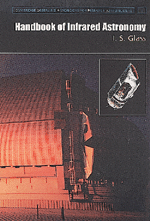4 - Spectroscopy
Published online by Cambridge University Press: 01 October 2009
Summary
Introduction
We can consider spectroscopy at several different resolution levels.
The crudest resolution amounts to photometry, where the wavelength scale is divided into a small number of regions, or wide bands, to give an indication of a spectral energy distribution (SED). Examples might include the U(0.37), B(0.44), V(0.55), R(0.64) and I(0.80 μm) system in the visible region and the J(1.25), H(1.65), K (2.2), L(3.5), M(4.8), N(10), and Q(20 μm) system of ground-based infrared, as well as the 12, 25, 60 and 100 μm IRAS bands.
Many data with Δλ/λ ∼ 0.01 exist from spectrometers that used circular variable filters (CVFs). This is usually considered to be the least resolution which can really be called spectroscopy.
The next level might be called medium-resolution spectroscopy, where the detailed lines that usually compose molecular bands are not seen, but the bands are treated in an averaged manner. Most infrared spectroscopy falls into this category.
With high-resolution spectroscopy the individual molecular lines can be examined. Sensitivity considerations have limited this type of work hitherto to the study of the Sun, bright stars and planets. With the advent of large infrared array detectors and large telescopes, it is reasonable to predict that fainter objects will soon receive attention. High resolution has in the past been obtained through the use of Fabry–Perot etalons or Michelson interferometers, also called Fourier–transform spectrometers.
Stellar spectra
The theoretical study of stars is usually divided into stellar interiors and stellar atmospheres. The output of the interior can be regarded as something like a blackbody, but the atmosphere modifies the emergent flux according to its temperature structure, pressure structure and composition.
- Type
- Chapter
- Information
- Handbook of Infrared Astronomy , pp. 73 - 104Publisher: Cambridge University PressPrint publication year: 1999



